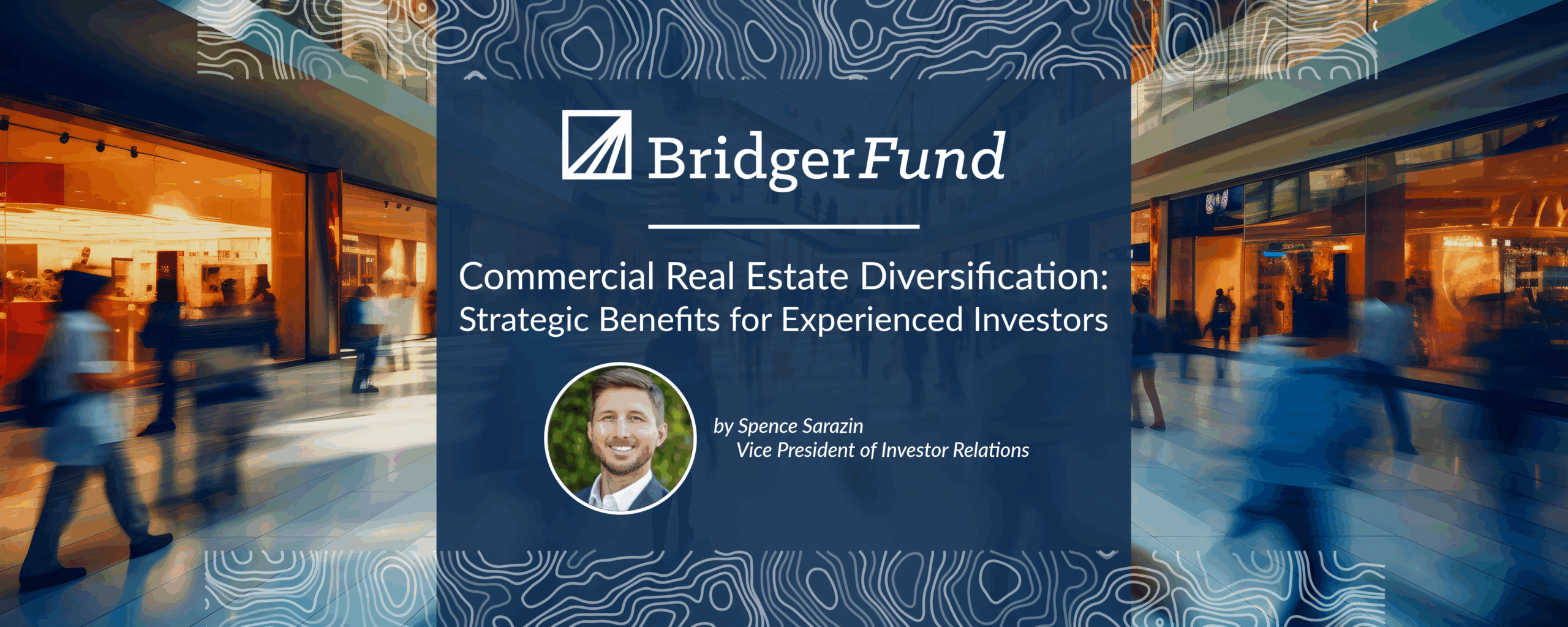
Commercial Real Estate Diversification: Strategic Benefits for Experienced Investors
Record stock market indexes and the highest recorded levels of economic uncertainty have prompted experienced commercial real estate investors to reconsider traditional approaches to portfolio construction. A growing body of evidence suggests that diversification across multiple dimensions of commercial real estate can enhance risk-adjusted returns and provide valuable downside protection. Here are 4 ways an experienced commercial real estate investor can reduce volatility in their portfolio through diversification:
- Geographic Diversification: Capturing Regional Growth Cycles
Geographic diversification represents one of the foundational strategies in commercial real estate investing. Different regions experience distinct economic cycles, regulatory environments, and demographic trends that create varying performance patterns over time.
California’s diverse commercial real estate markets provide compelling examples of this principle across different time periods. During the dot-com boom of the late 1990s and early 2000s, Bay Area markets like San Francisco and Silicon Valley experienced extraordinary growth, while Central Valley markets like Sacramento and Fresno remained relatively stable. When the tech bubble burst, these roles reversed, with secondary markets providing stability while coastal tech-heavy regions faced significant corrections.
The 2008-2012 financial crisis illustrated another dimension of geographic diversification within the state. Markets heavily exposed to residential development and construction, such as the Inland Empire, experienced severe distress, while more diversified urban cores like downtown Los Angeles and San Francisco showed greater resilience due to their varied economic bases.
More recently, the pandemic and subsequent shift toward remote work created yet another geographic performance differential. Traditional tech and financial centers faced challenges from reduced office demand and population shifts, while secondary markets benefited from migration patterns as residents and businesses sought more affordable alternatives. Markets like Sacramento, Fresno, and parts of the Central Valley experienced increased demand as they offered lower costs while maintaining reasonable access to major metropolitan areas.
Even within specific regions, micro-market diversification proves valuable. Within Los Angeles County, submarkets like downtown, Century City, Santa Monica, and the San Fernando Valley can perform differently based on their tenant composition, transportation access, and local economic drivers. Similarly, the San Francisco Bay Area encompasses distinct markets from the Financial District to Silicon Valley to Oakland, each responding to different economic forces.
Geographic diversification also provides opportunities to benefit from varying regulatory environments. Different states offer varying tax structures, regulatory frameworks, and business policies that can impact investment returns. California’s complex regulatory environment creates additional variations between markets, with some cities offering more business-friendly policies while others impose stricter development controls or rent regulations. Thoughtful investors may structure portfolios to capture these advantages while mitigating jurisdiction-specific risks.
The key insight for investors is that economic cycles rarely affect all markets uniformly, even within the same state. By spreading investments across different geographic markets, investors can potentially benefit from regions experiencing growth while being protected from those facing challenges, ultimately creating more stable and resilient portfolio performance over time.
- Property Type Diversification: Balancing Growth and Stability
Property type diversification offers valuable risk-return optimization opportunities in commercial real estate. Each asset class responds differently to economic drivers, demographic shifts, and technological disruption, creating natural hedging opportunities.
Current cap rate data from CBRE surveys reveals significant differences across property types. As of H2 2024, retail properties command the highest cap rates, reflecting higher risk premiums, while multifamily properties typically show lower cap rates due to perceived stability. Office properties have seen substantial cap rate expansion, with Class A offices exceeding 8% cap rates in many markets.
Industrial properties have demonstrated notable resilience during recent market cycles. E-commerce growth and supply chain restructuring created substantial demand for logistics facilities. Healthcare real estate shows another dimension of diversification, with sub-sectors like senior housing, medical office buildings, and specialty healthcare facilities offering different risk-return profiles within the broader healthcare category.
The emergence of alternative property types including datacenter, self-storage, cold storage, life sciences facilities, and experiential retail provides additional diversification opportunities.
However, recent market data illustrates how quickly property type performance can shift, demonstrating the importance of diversification timing and market awareness. According to the Southern California Commercial Association of Industrial’s Q3 2025 market outlook, Southern California’s commercial real estate markets are experiencing significant sector-specific adjustments that highlight diversification benefits.
The industrial sector, which was the “hottest sector of the past decade,” has seen vacancy rates climb from historic lows as new construction meets the market. Greater Los Angeles industrial vacancy reached approximately 4.9% in Q1 2025, the highest in a decade, after bottoming out below 2% in 2021. The Inland Empire experienced an even more dramatic shift, with vacancy jumping from near 1% two years ago to 7.4% in early 2025, though it showed signs of stabilization with positive net absorption.
Meanwhile, the office sector faces the most challenging conditions, with Los Angeles County office vacancy hitting 24.5% in Q1 2025, representing the 11th consecutive quarter of occupancy losses. However, the retail sector has demonstrated remarkable resilience, with vacancy rates remaining in the low-to-mid single digits across Southern California markets, while multifamily properties maintain fundamentally strong performance with occupancy rates in the mid-90s despite record new deliveries.
These recent developments underscore how property type diversification must account for changing market cycles. Sectors that performed exceptionally well during one period may face challenges in subsequent cycles, while others maintain stability or even benefit from shifting conditions, reinforcing the value of spreading investments across multiple property types and maintaining awareness of evolving market fundamentals.
- Tenant and Industry Diversification: Mitigating Concentration Risk
Tenant concentration represents an important consideration in commercial real estate investing. Single-tenant properties or portfolios concentrated in specific industries can face significant challenges when anchor tenants experience financial distress or entire sectors undergo disruption.
The retail sector transformation of recent years provided valuable lessons about tenant diversification. Shopping centers anchored by traditional department stores experienced significant valuation declines, while mixed-use properties with diverse tenant bases including dining, entertainment, and services showed greater resilience.
The COVID-19 pandemic illustrated the importance of industry diversification. Properties with technology, healthcare, and essential services tenants maintained higher occupancy rates, while those concentrated in hospitality, entertainment, and discretionary retail experienced substantial occupancy drops. Experienced investors often target tenant bases with no single tenant representing more than 15% of total revenue and no single industry exceeding 25% of portfolio exposure.
- 4. Asset Class Diversification: The Overlooked Power of First-Position Debt Investments
While most discussions of commercial real estate diversification focus on equity investments, first-position debt instruments secured by commercial real estate represent an important yet often underexamined diversification strategy. These investments provide a different risk-return profile that can enhance portfolio stability and income generation, particularly during market downturns when equity valuations face pressure.
First-position commercial real estate debt offers several noteworthy advantages. Unlike equity investments, debt instruments provide contractual income streams that remain stable regardless of property valuation fluctuations. Federal Reserve data shows that commercial real estate loan delinquency rates, while they peaked during the 2008-2012 financial crisis, remained at manageable levels for well-underwritten loans and have generally trended lower in recent years.
The security structure of first-position debt provides multiple layers of protection that equity investments cannot match. Beyond the primary collateral of the underlying real estate, these instruments typically include personal guarantees from sponsors, additional collateral, and priority claim status in any workout or foreclosure scenario. This security structure has shown value during market stress periods when equity investors often face total losses.
Current market conditions suggest first-position debt may offer attractive opportunities. With commercial real estate cap rates having expanded and equity valuations under pressure, debt investments may offer favorable risk-adjusted returns. Quality first-position commercial mortgages currently yield attractive returns while maintaining downside protection through conservative loan-to-value ratios typically ranging from 50-65%.
The income stability of debt investments provides valuable portfolio ballast during volatile periods. While equity investments may suspend distributions during market stress, debt instruments continue generating contractual interest payments as long as borrowers remain current. This characteristic can prove valuable during market downturns when many equity distributions are cut or suspended.
Conclusion: Building Tomorrow’s Resilient Real Estate Portfolios
Commercial real estate diversification extends beyond traditional approaches. For experienced investors, diversification represents thoughtful risk management across multiple dimensions. Geographic spreading captures regional growth cycles while mitigating local market risks. Property type diversification leverages secular trends while providing natural hedges against sector-specific disruption. The presence of high-quality senior position debt investments smooth out the returns of the overall portfolio.
The evidence supports diversified approaches across multiple market cycles. Portfolios incorporating these diversification dimensions have often provided better risk-adjusted performance while offering valuable downside protection during market stress periods. In an era of increasing market complexity and evolving economic conditions, diversification represents an important consideration for building resilient commercial real estate portfolios.


